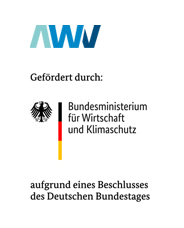AWV-Interview: Goodbye, manual process! The end-to-end digitalised supply chain becomes reality

AWV Interview with Cyrille Sautereau, Chair of the Forum National de la Facture Electronique et des Marchés Publics Electroniques, and Ivo Moszynski, Chair of the Forum for Electronic Invoicing Germany.
On 13th April 2021 Order-X, the electronic standard for digitalised order processing was released. Like the ZUGFeRD/Factur-X invoice format, Order-X was developed by the French experts of the Forum National de la Facture Electronique et des Marchés Publics Electroniques (FNFE-MPE) and the honorary specialists of the German AWV working group 4.6 "Forum elektronische Rechnung Deutschland" (FeRD). For whom is this new ordering standard interesting, and what are the advantages?
Ivo Moszynski (FeRD): With the release of Order-X, FNFE-MPE and FeRD were able to show their strong cooperation while offering the market a hybrid format for electronic order processing. Order-X is interesting for all companies that have already started to digitalise their processes or are planning to do so. Companies that have already digitised parts of the process chain can also integrate Order-X.
In particular, Order-X can be used very well by companies in B2B business transactions. In principle, usability with public administration should also be possible. Here, specific requirements may need to be clarified in advance.
In addition, companies that already process incoming and/or outgoing invoices electronically via ZUGFeRD/Factur-X have ideal conditions. Order-X and ZUGFeRD/Factur-X are based on the same model: In their hybrid form they basically consist of a view component (PDF file) and purely structured data (XML file). This structure is a clear advantage, as it allows companies that have not yet set up their processes in an automated way to process them. On the other hand, companies that already work digitally can also integrate Order-X. I see further advantages in the promotion of digitalised supply chains, in cost savings and in faster process handling.
Cyrille Sautereau (FNFE-MPE): Like for invoices, the ordering process is split in two worlds: EDI with full structured order messages between large companies and a part of their first-tier suppliers, full integrated, and paper or simple PDF orders sent by emails to SMEs or through portals where they have to connect to retrieve and process them, which also means that they have to manually enter the relevant information into their own information system for production, delivery and invoicing.
Order-X has been designed mainly to replace this second flow with PDF documents which already contains a set of structured data in order to provide to SMEs added value documents which can be easily integrated automatically in their information system when they are ready to use it and at the same time usable as PDF document readable and processable by final human users.
In addition, the set of structured data has been designed under the state of the art of UN/CEFACT standards, using the SCRDM (Supply Chain Reference Data Model) which already implements Factur-X
for the invoice process compliant with the European Norm EN16931.
Order-X and Factur-X are key to onboard SMEs into a full integrated e-supply chain, taking in account their capabilities with flexibility.
What is new about the further development of ZUGFeRD 2.2, and what are the future plans for ZUGFeRD/Factur-X?
Ivo Moszynski: Currently, detailed discussions are underway for the planned update of ZUGFeRD/Factur-X. In addition to minor error corrections, the change requests submitted by the German and French sides are being reviewed among the experts. Here, intensive consideration is being given to which changes are required to be incorporated and which changes are currently being discussed at the higher level of the European
Committee for Standardisation (CEN). The decisions taken at CEN level are distributed to the EU member states via the national standardisation bodies.
Although some details of the new version of ZUGFeRD/Factur-X are still being discussed in the forthcoming weeks, it is certain that the revised documents of ZUGFeRD/Factur-X will be made available to interested parties via a public review before publication. This will give everyone the opportunity to report any errors in advance or to make suggestions for the improvement of the format.
Cyrille Sautereau: After B2G full deployment in 2020, France is now preparing a Continuous Transactional Control reform based on an obligation to exchange e-invoices on domestic B2B, in addition with e-reporting on B2C and international sales and on e-invoice payment. It will be built on top of the existing B2G ChorusPro platform, in addition to certified private platforms which will constitute all together a global e-invoice exchange network. It means that all SMEs will have to send and receive their domestic invoices in an electronic form and format through it, with a restricted set of invoice information (globally the fiscal and legal mandatory fields) to be sent to the Tax Administration on a real time basis. Factur-X will be the key to support this reform and provide at the same time a readable PDF invoice as all SMEs are used to process and a set of invoice data which will have to be extracted for clearance and will be available for process automation.
An obligation for all companies and all invoices means that the formats will have to support all business cases in place, which may need to review the Factur-X extended profile in order to address 100 % of existing invoices.
FNFE-MPE and FeRD will then continue their collaboration to update the Factur-X standard in order to address their respective needs, which also be a contribution to other initiatives in Europe on Continuous Transactional Control.
What do you see as the strengths of the Franco-German cooperation that exists since 2015, and what topics would you like to advance together?
Cyrille Sautereau: Since 2015, France and Germany have shared the same conviction that supply chain automation and digital transformation will succeed only if SMEs can be massively onboarded. Our collaboration on hybrid documents, but also on international standardisation processes like the EN16931 and UN/CEFACT SCRDM, will contribute to support massive adoption at a large scale with millions of companies and billions of invoices to address. We will continue to share good practices and experience and build the conditions to support the full adoption of an e-supply chain for all, for instance by completing the model with delivery documents.
Ivo Moszynski: Over the years, FNFE-MPE and FeRD have been working together very successfully. There has been a wide variety of new legal and technical requirements for digitised supply chain processes that had to be brought into line with the respective national regulations.
In May 2019, FNFE-MPE and FeRD have strengthened their cooperation for the future with the conclusion of a renewed Memorandum of Understanding in Brussels, and they have managed to raise the requirements to a higher, cross-national level in order to create formats that can also be used in other countries.
In the forthcoming months and years, FNFE-MPE and FeRD will increasingly engage in decision-making processes at the European level and advance the further digitalisation of the supply chain.
Bild: AdobeStock, BillionPhotos_com

